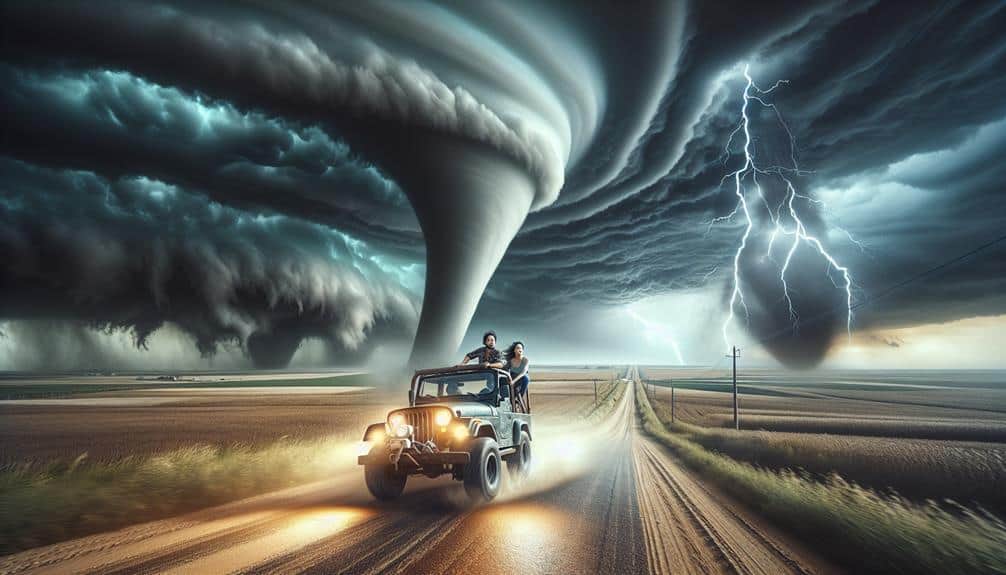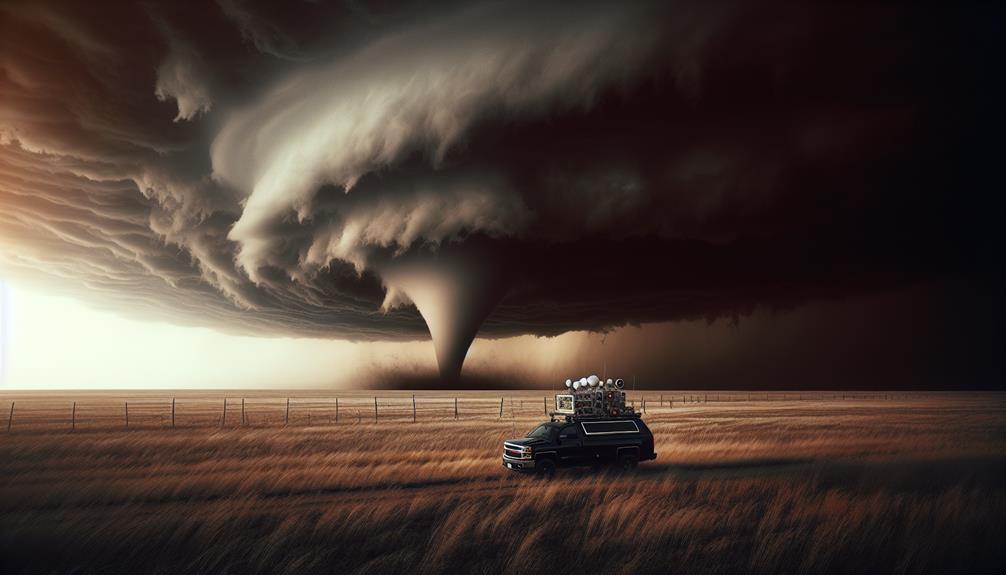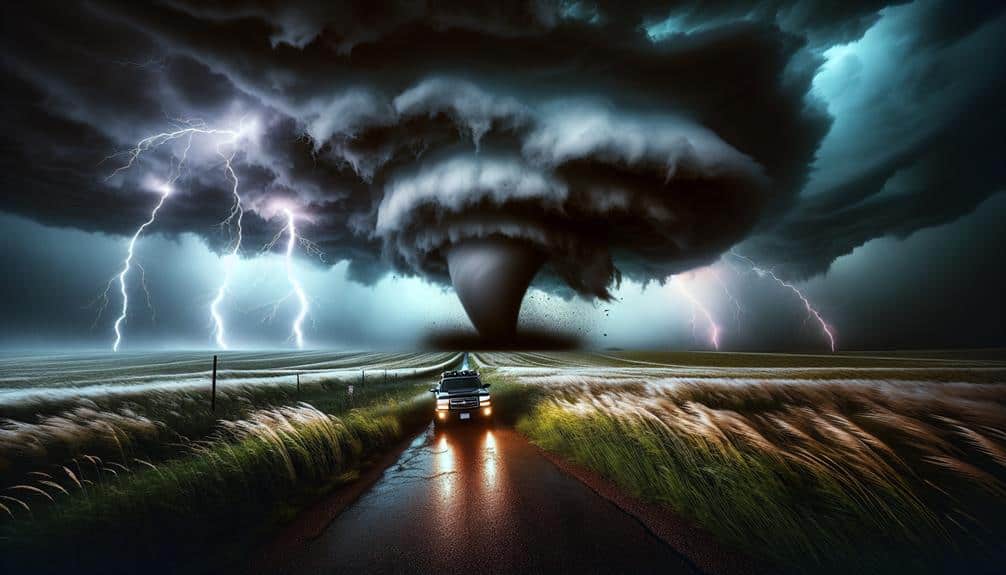We've harnessed advanced meteorological tools and systematic methodologies to transform storm chasing from a perilous endeavor into a crucial scientific pursuit. Early meteorologists driven by curiosity leveraged weather balloons and radar for storm data, while pioneers like Tim Samaras with his 'turtle' probe and Dr. Josh Wurman with Doppler on Wheels revolutionized our understanding of severe weather. Contrary to myths, storm chasers operate cautiously, using cutting-edge technologies to provide essential data and emergency warnings. Iconic documentaries highlight the meticulous, team-based approach in storm chasing, promoting environmental awareness and scientifically accurate storm research, revealing how much more lies beneath the surface.
Key Points
- Storm chasers follow strict safety protocols and use advanced meteorological tools to minimize risks.
- Storm chasing significantly contributes to meteorological research, improving early warning systems and emergency response.
- Documentaries on storm chasing highlight the scientific rigor and teamwork involved, not just thrill-seeking.
- Technological advancements, such as high-resolution Doppler radars and drones, enhance storm tracking and data collection.
Origins of Storm Chasing
The origins of storm chasing can be traced back to the early 20th century when advancements in meteorology and transportation made it feasible to systematically study severe weather phenomena. As we explore this historical context, it's clear that scientific curiosity was a driving force. Early meteorologists, equipped with rudimentary forecasting tools, wanted to understand the mechanics of storms.
By the 1920s and 1930s, the advent of automobiles and improved road networks facilitated unprecedented mobility, allowing us to track storm systems as they developed. This period marked a significant shift from passive observation to active pursuit. Weather balloons, early radar systems, and the first attempts at aerial reconnaissance provided invaluable data that enhanced our understanding of storm dynamics.
In the 1940s and 1950s, the integration of more sophisticated radar technology and the establishment of the U.S. Weather Bureau's storm prediction efforts further fueled our collective scientific curiosity. Researchers and enthusiasts alike were now able to predict and chase storms with greater accuracy. This era laid the groundwork for the modern practice of storm chasing, blending cutting-edge technology with an insatiable quest for knowledge.
As we reflect, it's evident that our pursuit of freedom in the face of nature's fury has always been intertwined with a desire to explore the mysteries of severe weather.
Famous Storm Chasers
Among those who built upon the early advancements in meteorology and technology, several individuals emerged as pioneering storm chasers whose contributions advanced our understanding of severe weather phenomena to a great extent.
Tim Samaras, for instance, is renowned for his chaser profiles that include significant advancements in tornado research. Utilizing the probe known as the 'turtle,' his work provided unprecedented data on tornado pressure drops. Samaras' impactful moments include capturing a 100 millibar pressure drop within seconds, a feat that has fundamentally altered our grasp of tornado dynamics.
Dr. Josh Wurman is another pivotal figure. His creation of the Doppler on Wheels (DOW) revolutionized radar meteorology, allowing for mobile, high-resolution data collection during severe weather events. By tracking tornadoes with extraordinary precision, Wurman's contributions have been critical in developing more accurate predictive models.
Popular Myths Debunked
Many misconceptions about storm chasing persist, often rooted in outdated information or sensationalized media portrayals. One prevalent myth is that storm chasers operate recklessly, driven purely by adrenaline. In reality, we adhere to strict safety precautions, including utilizing advanced meteorological tools like Doppler radar and GPS tracking to monitor storm movements. These tools allow us to maintain a safe distance while gathering valuable data.
Another myth suggests that storm chasing is a hobby for thrill-seekers with little scientific value. Contrary to this belief, our work contributes significantly to meteorological research. By collecting real-time data on storm dynamics, we aid in improving predictive models and enhancing public safety.
Media portrayals often depict storm chasers as lone adventurers, but we typically operate in coordinated teams, each member having specific roles such as navigation, communication, and data collection. This teamwork ensures operational efficiency and safety.
Lastly, there's a misconception that storm chasing endangers communities. In truth, our presence often provides early warnings and assists local authorities in emergency response. By debunking these myths, we hope to shed light on the critical, scientifically-driven nature of storm chasing and its contributions to society.
Iconic Documentaries
Iconic documentaries have played a key role in showcasing the rigorous scientific efforts and teamwork involved in storm chasing, dispelling many of the myths that surround our profession. Through cinematic storytelling, these documentaries provide thrilling adventures that capture the raw power of nature while emphasizing the precision and dedication required to study severe weather phenomena. Notable documentaries like 'Tornado Alley' and 'Chasing Ice' haven't only thrilled audiences but also heightened awareness of meteorological science.
The cultural impact of these documentaries can't be overstated. By bringing storm chasing into the public eye, they foster a deeper understanding of atmospheric dynamics and the importance of weather prediction. These films often incorporate cutting-edge technology, such as Doppler radar and high-resolution satellite imagery, to present data with scientific accuracy. This helps demystify the processes involved and corrects misconceptions about our work.
Moreover, these documentaries play a crucial role in environmental awareness. By illustrating the effects of climate change on storm frequency and intensity, they underscore the need for sustainable practices and informed policy decisions. Our profession is portrayed not just as one of thrilling adventures, but also as a significant component of environmental stewardship, raising awareness and inspiring action.
Behind the Scenes

Behind the scenes, we meticulously calibrate our instruments and analyze atmospheric data to guarantee the highest accuracy in storm prediction and tracking. This precision allows us to navigate the hidden dangers and experience the adrenaline rush that comes with storm chasing. Our process involves a combination of high-tech equipment and detailed meteorological analysis.
- Doppler radar systems: These provide real-time data on wind patterns and precipitation intensity, vital for predicting storm paths.
- Anemometers: These measure wind speed, helping us gauge the potential severity of a storm.
- Satellite imagery: This offers a macro view of storm systems, allowing us to track their development over time.
We rely on these tools to not only chase storms but also to contribute valuable information to the broader scientific community.
The adrenaline rush we experience is tempered by an acute awareness of the hidden dangers we face, from lightning strikes to rapidly changing weather conditions.
Our commitment to scientific accuracy and data-driven decision-making is what keeps us safe and effective in the field.
Future of Storm Chasing
As we look ahead, storm chasing will be profoundly shaped by advancements in sensor technology and data analytics, enabling more accurate and timely predictions.
We must also address the ethical implications and prioritize safety protocols to guarantee responsible and secure operations.
These developments promise to revolutionize our approach and understanding of severe weather phenomena.
Technological Advancements in Equipment
In recent years, we've witnessed significant advancements in storm chasing equipment, driven by innovations in radar technology, drones, and real-time data analytics. These technological leaps have revolutionized how we approach storm chasing, offering unprecedented safety and precision.
Radar innovation has been pivotal. Modern Doppler radars provide high-resolution imagery, allowing us to pinpoint storm structures with exceptional accuracy. This enhances our ability to predict tornado formation and other severe weather phenomena.
Drone surveillance has also transformed our capabilities. Equipped with high-definition cameras and sensors, drones can safely navigate storm environments, capturing critical data from altitudes that are otherwise inaccessible. This airborne perspective allows us to measure wind speeds, temperature gradients, and humidity levels in real-time.
The integration of real-time data analytics into our operations has further improved our decision-making processes. Advanced algorithms analyze incoming data streams, providing instant insights and enabling rapid adjustments to our strategies.
Key advancements include:
- High-resolution Doppler radars
- Advanced drone surveillance systems
- Real-time data analytics platforms
These advancements not only empower us to chase storms more effectively but also contribute to our broader understanding of severe weather patterns, ultimately enhancing public safety and our collective freedom to explore nature's extremes.
Ethical Considerations and Safety
While technological advancements have revolutionized storm chasing, they also necessitate a rigorous examination of ethical considerations and safety protocols for the future. As storm chasers, we must prioritize safety while leveraging new technologies.
Enhanced radar systems and advanced modeling software enable us to predict storm paths with unprecedented accuracy. However, this also means we often find ourselves closer to danger, making adherence to strict safety protocols essential.
One of the primary ethical dilemmas we face is the balance between gathering scientific data and ensuring public safety. For instance, should we share real-time data that could potentially cause public panic, or should we delay dissemination to verify accuracy? Moreover, the influx of amateur storm chasers, driven by adrenaline rather than scientific purpose, raises concerns about both their safety and the integrity of our data.
We also need to take into account the environmental impact of our activities. Chasing storms often requires significant fuel consumption, contributing to carbon emissions. As responsible stewards of the environment, we must explore sustainable practices, such as using electric vehicles and minimizing unnecessary travel.
Frequently Asked Questions
What Safety Precautions Do Storm Chasers Follow During Their Expeditions?
When we're riding the storm's edge, our emergency protocols are our lifeline. We prioritize rigorous vehicle maintenance, real-time weather tracking, and constant communication. These measures, like a well-oiled machine, guarantee both our safety and freedom.
How Do Storm Chasers Communicate While Tracking a Storm?
We use advanced communication methods and technology like radios, GPS, and real-time data sharing for team coordination. Our tactics involve constant updates on storm movements, ensuring everyone knows their roles and stays safe while tracking.
What Equipment Is Essential for Storm Chasing?
For storm chasing, we rely on tracking software, drones, and weather balloons to gather real-time data. High-resolution radar is essential for monitoring storm development. This equipment enhances our ability to predict and respond to severe weather effectively.
Are There Any Legal Restrictions on Storm Chasing?
Yes, there are legal restrictions and ethical considerations in storm chasing. We must adhere to local laws, avoid trespassing, and prioritize safety. Responsible behavior guarantees our freedom to chase storms while respecting community and environmental boundaries.
How Do Storm Chasers Contribute to Scientific Research?
We collect critical data during storms, directly impacting meteorological research. Our data collection helps improve predictive models and understand storm dynamics. With accurate data, we enable freedom through better preparedness and safety measures for the public.


